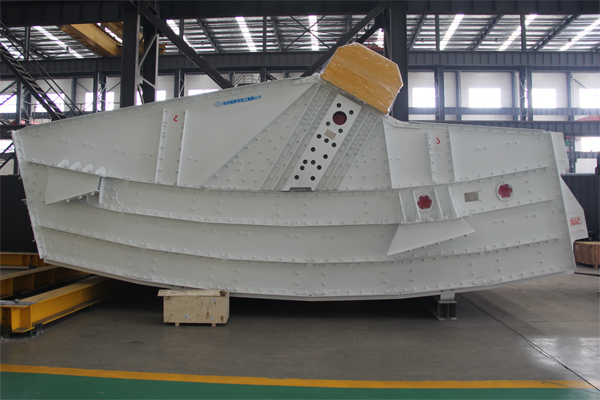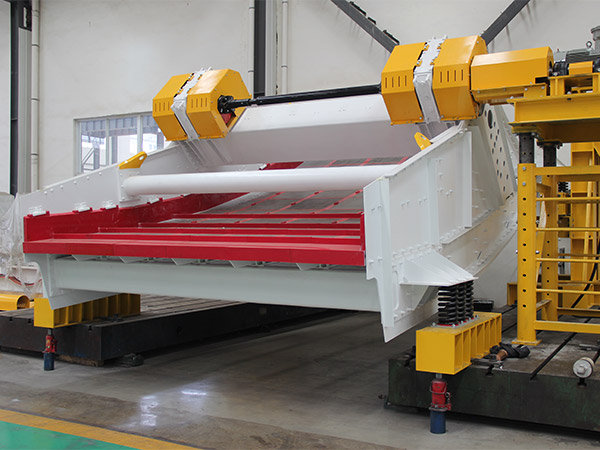A linear vibrating screen is a screening machine that uses vibration to separate materials based on size. It operates using a linear motion, which is generated by two counter-rotating vibratory motors or exciters. These vibrations cause the material to move forward while allowing smaller particles to pass through the screen mesh, effectively sorting and classifying materials. The technical parameters of a linear vibrating screen can be quite extensive, depending on the manufacturer and specific application.
Linear vibrating screen technical parameters

1. Mechanical and Dimensional Parameters:
Screen Size (Length x Width): This is the active screening area, often in meters (m) or millimeters (mm). It’s crucial for determining the throughput capacity of the screen. e.g., 1.5m x 3m, 2m x 4m.
Overall Dimensions (Length x Width x Height): Total physical size of the machine, including the frame, motor, and other components. Important for space planning.
Weight: The total weight of the machine in kilograms (kg) or metric tons (t). Relevant for transportation and installation considerations.
Number of Decks: How many screening surfaces are stacked on top of each other. Single-deck screens perform a single separation, while multi-deck screens can perform multiple separations in one pass.
Deck Inclination Angle: The angle of the screen deck relative to the horizontal. This influences material flow rate and screening efficiency. Typically a small angle (e.g., 5-10 degrees).
Mesh Size (Aperture Size): The size of the openings in the screen mesh, in millimeters (mm) or micrometers (µm). Determines the cut size (separation size). Each deck in a multi-deck screen will have a different mesh size.
Mesh Material: The material used for the screen mesh, such as stainless steel (common grades: 304, 316), woven wire cloth, perforated plate, polyurethane, or rubber. The choice depends on the material being screened and the required durability.
Frame Material: The material used for the screen frame, typically carbon steel (with coating for corrosion resistance) or stainless steel.
Screening Area (Total): The total active area of all screening decks combined.
2. Vibration Parameters:
Vibration Frequency: The number of vibration cycles per second, measured in Hertz (Hz) or cycles per minute (CPM). Frequency affects the material’s agitation and movement on the screen.
Vibration Amplitude (Stroke): The distance the screen deck moves during each vibration cycle, in millimeters (mm). Amplitude influences the material’s throw and the screening rate. Often adjustable.
Excitation Force: The force generated by the vibratory motor to drive the screen, measured in Newtons (N) or kilonewtons (kN). It’s related to the motor’s power and the eccentric weight.
Vibration Direction: The direction of the vibratory motion, which is typically linear (straight line) for linear vibrating screens. The angle of the linear motion relative to the screen surface can be a factor.
Vibrator Type: The type of exciter used to generate the vibrations. Common types include:
Vibratory Motors (Unbalanced Motors): Two motors with eccentric weights rotating in opposite directions. This is the most common type.
Electromagnetic Vibrators: Used for smaller screens.
Mechanical Vibrators: Driven by belts and pulleys.

3. Operational and Performance Parameters:
Capacity/Throughput: The amount of material the screen can process per unit of time, typically measured in metric tons per hour (t/h) or kilograms per hour ( kg/h ). Capacity is heavily dependent on the material being screened, its particle size distribution, and the screen parameters.
Screening Efficiency: The percentage of material smaller than the mesh size that passes through the screen. A higher efficiency means less of the fine material ends up in the oversize product. Often expressed as a percentage (e.g., 95%).
Separation Size (Cut Size): The particle size that is being separated by the screen. Ideally, all particles smaller than this size pass through, and all particles larger than this size are retained on the screen. It’s determined by the mesh size.
Feed Size (Maximum Particle Size): The maximum size of the particles that can be fed into the screen without causing damage or blockages.
Feed Rate: The rate at which material is fed onto the screen, which directly impacts the screen’s performance and capacity.
Moisture Content (Maximum): The maximum allowable moisture content of the feed material. Excessive moisture can cause clogging and reduce screening efficiency. Expressed as a percentage.
Power Consumption: The electrical power required to operate the screen, measured in kilowatts (kW).
Noise Level: The noise generated by the screen during operation, measured in decibels (dB). Important for workplace safety.
Dust Emission: The amount of dust released during screening. This is important for environmental considerations, and often requires dust collection systems.
4. Motor Parameters (for Vibratory Motor-Driven Screens):

Motor Power: The power of the vibratory motor(s), in kilowatts (kW) or horsepower (HP).
Motor Speed: The rotational speed of the motor(s), in revolutions per minute (RPM).
Voltage and Frequency: The electrical power requirements (e.g., 380V/50Hz, 440V/60Hz).
Insulation Class: The temperature rating of the motor’s insulation (e.g., Class F, Class H).
Protection Class: The motor’s protection against dust and water ingress (e.g., IP54, IP65).
Number of Poles: Determines the synchronous speed of the motor.
5. Additional Features and Options:
Spray System: Water or liquid spray nozzles to help separate sticky or dusty materials.
Dust Cover: Enclosure to minimize dust emissions.
Screen Cleaning System: Devices to prevent screen blinding (blockage), such as bouncing balls, ultrasonic vibration, or rotating brushes.
Explosion-Proof Design: For use in hazardous environments where flammable materials are present.
Variable Frequency Drive (VFD): Allows for adjustable vibration frequency and amplitude.
Remote Control: For convenient operation and monitoring.
Material of Construction (Contact Parts): Specifies the materials used for parts that come into contact with the screened material (e.g., stainless steel for food-grade applications).
Lubrication System: Details of the lubrication method and required maintenance.
Importance of Specifying Parameters:

It’s crucial to specify all relevant technical parameters when selecting or designing a linear vibrating screen to ensure it meets the specific requirements of the application. Incorrect parameters can lead to:
Inefficient Screening: Poor separation of materials.
Low Throughput: Unable to process the required amount of material.
Equipment Failure: Overloading the screen or using it with unsuitable materials.
Increased Maintenance Costs: Frequent repairs due to improper operation.
Unsafe Operation: Noise, dust, and potential hazards.
When requesting information from a manufacturer, be prepared to provide details about the material you intend to screen, the desired throughput, and the required separation size. This will help them recommend the most suitable screen and provide accurate technical parameters.










